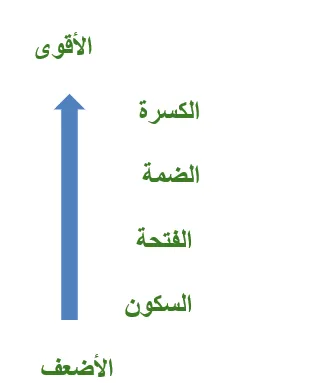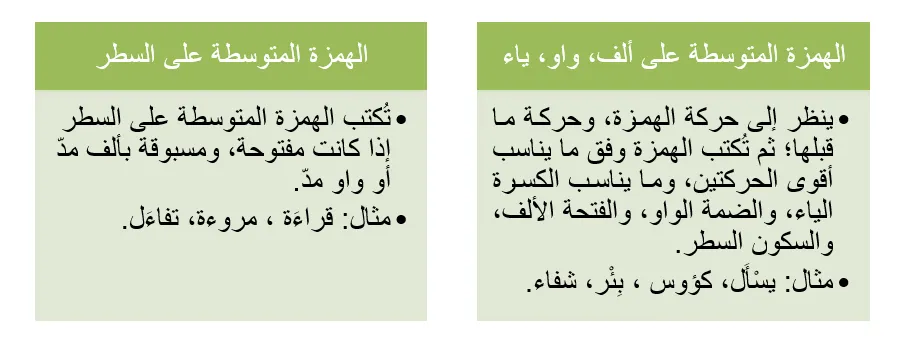Introduction:
This part discusses the definition of the Middle Hamza, the rules for determining its correct position, and gives explained examples for each type of Middle Hamza. It concludes with a diagram summarizing the positions of the Middle Hamza.
What is the Middle Hamza?
The Middle Hamza is the hamza that occurs in the middle of a word, whether the word is a noun or a verb. It has four types as follows:
أ- sa’ala (سَأَل): Middle Hamza on Alif.
ب- mu’min(مُؤْمِن): Middle Hamza on Waw.
ت- sā’im (صائِم): Middle Hamza on Ya.
ث- tafa’ala (تفاءَل): Middle Hamza on the line.
How do we write the Middle Hamza correctly?
There is a fixed rule for writing each type of the Middle Hamza, as follows:
1- The Middle Hamza on Alif, Waw, or Ya.
The rule that helps you determine the correct form of the Middle Hamza on Alif, Waw, or Ya is:
| Look at the vowel (harakah) of the hamza and the vowel of the letter before it. The Middle Hamza is then written according to the stronger of the two vowels, based on the order of strength: Kasra is the strongest, then Damma, then Fatha, then Sukoon. Example: yas’al Zayd the teacher about the date of the exam (يسْأَل زيدٌ المعلمَ عن موعد الامتحان).Here, the hamza in (yas’al) is written on Alif, because it is open (fatha) and preceded by sukoon. Fatha is stronger than sukoon, and what suits fatha is Alif. |
 |
| A chart illustrates the ranking of vowel strength: Kasra → Damma → Fatha → Sukoon. |
| Note:أ- If the hamza is preceded by a long vowel (Alif, Waw, or Ya), this means it is preceded by a letter whose vowel is sukoon, such as: ṭā’ir (طائر) – sā’ir (سائر) – ḍaw’uhu (ضوؤه). Example: The moon’s light diminished (القمرُ تضاءل ضوؤه). |
| ب- An exception to the rule of the Middle Hamza on Alif: if the hamza is open (fatha) after a still Ya (ya with sukoon), then it is written on a Ya (nabr) not on Alif. Examples: hay’a (هيئة) – bī’a (بيئة) – mashī’a (مشيئة). |
2- The Middle Hamza on the Line.
The Middle Hamza is written on the line in either of these two cases:
1- When the Middle Hamza is open (fatha) and preceded by a long Alif → qirā’a (قراءة)
2- When the Middle Hamza is open (fatha) and preceded by a long Waw → makhbū’a (مخبوءة)
– Examples from Classical Texts for All Types of the Middle Hamza:
| Middle Hamza on Alif | Middle Hamza on Waw | Middle Hamza on Ya | Middle Hamza on the Line | |
| Example 1. | Allah says: “When Joseph said to his father, ‘O my father, indeed I saw [in a dream] eleven stars and the sun and the moon; I saw them prostrating to me.” (رَأَيت – رَأَيتهم) | Allah says: “And most of them believe not in Allah except while they associate others with Him.” (يُؤمن) | Allah says: “I fear that a wolf may eat him.” (يَأْكله الذِّئْب) | The Prophet ﷺ said: “Be optimistic about good and you will find it.” (تفاءَلوا) |
| Analysis | The words (ra’aytu – ra’aytahum) are written with Middle Hamza on Alif, because the hamza is open and preceded by fatha. | The hamza in (yu’min) is written on Waw, because it is still (sukoon) and preceded by damma; damma is stronger than sukoon, so Waw is used. | The hamza in (al-dhi’b) is written on Ya, because it is still (sukoon) and preceded by kasra; kasra is stronger than sukoon, so Ya is used. | The hamza in (tafa’alu) is written on the line, because it is open and preceded by a long Alif. |
| Example 2. | Allah says: “Indeed, the righteous will drink from a cup [of wine] whose mixture is of Kafur.” (كَأْس) | Allah says: “Indeed, the hearing, the sight and the heart—about all those [one] will be questioned.” (الفُؤاد) | The Prophet ﷺ said: “The rights of a Muslim upon another are five: returning the greeting, visiting the sick, following the funeral, accepting invitations, and saying ‘yarhamuk Allah’ to the one who sneezes.” (الجنائز) | Umar ibn ‘Abd al- ‘Aziz said: “It is not of dignity to employ a guest.” (المروءة) |
| Analysis | The hamza in (ka’s) is written on Alif, because it is still (sukoon) and preceded by fatha; fatha is stronger than sukoon, so Alif is used. | The hamza in (fu’ad) is written on Waw, because it is open (fatha) and preceded by damma; damma is stronger than fatha, so Waw is used. | The hamza in (al-jana’iz) is written on Ya, because it is kasra and preceded by a long Alif (sukoon); kasra is stronger than sukoon, so Ya is used. | The hamza in (al-muru’a) is written on the line, because it is open and preceded by a long Waw. |
Conclusion:

An illustration showing the positions of the medial hamza in its four types.

